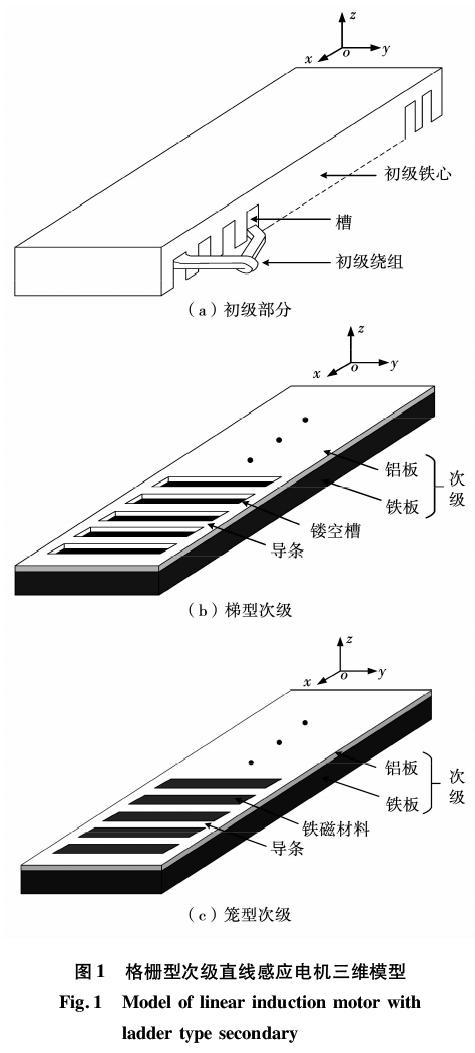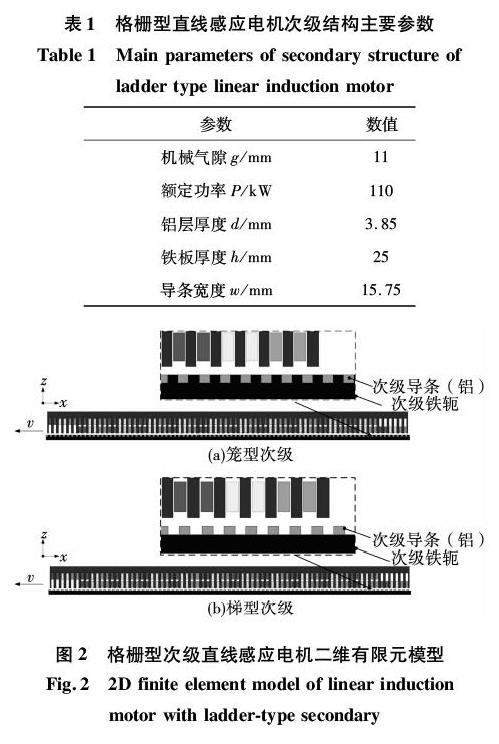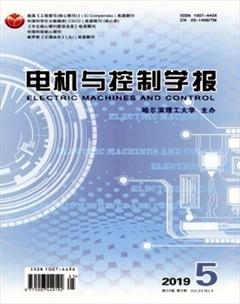不同槽配合格栅型直线感应电机电磁特性研究
吕刚 张贤



Abstract:In order to weaken the transverse end effect and increase the electromagnetic thrust, the ladder-type secondary was proposed as a new topology of linear motors. Based on the theory of electromagnetic field, the finite element analysis method was used to establish the finite element model of linear induction motor with two types of ladder-type secondary. In the transient field, the variation of the thrust and normal force amplitude and the fluctuation of force of linear induction motors with the two types of ladder-type secondary under different slot combinations were analyzed, besides, the eddy current distribution and the transverse air gap magnetic field distribution in ladder-type secondary and flat secondary were analyzed and compared. Considering the influence of the normal force, the net thrust characteristics of linear motor with the ladder-type secondaries were calculated under suitable slot combination,in the meantime the variation curves of the electromagnetic thrust and the normal force of two types of ladder-type secondary with the velocity were obtained. Through the above finite element analysis, it provides a theoretical reference for the optimization design of linear induction motor.
Keywords:linear induction motor; ladder-type secondary; the finite element analysis ; the transverse air gap magnetic field; thrust
0 引 言
随着直线电机轮轨车辆以及中低速磁悬浮列车等城市轨道交通工具的快速发展,其核心部件——直线感应电机的应用越来越广泛,相比传统轮轨机车采用的旋转电机,直线感应电机具有噪声小,爬坡能力强,工程造价低等众多优势[1]。应用于低速磁浮列车的直线感应电机不仅产生驱动列车的推力,还产生影响悬浮系统的法向力[2]。然而采用直线电机的城轨交通中也存在固有的缺点,因为次级感应板在直线电机车辆系统中沿线路铺设,成本较大;同时整体感应板的使用以及较大的气隙导致直线感应牵引电机的效率和功率因数较低。本文主要研究在控制制造成本的前提下,通过格栅型次级感应板来提升直线感应电机的各项电磁性能,主要考查对象为笼型格栅次级和梯型格栅次级。
文献[3]提出“等效电磁极距”的概念考虑电机的纵向端部效应,给出不同极数时极距的修正系数。文献[4]对次级复合感应板的单边直线感应电机气隙磁密的分析,得到了适合解耦控制用的直线感应电机动态数学模型和推力和法向力的解析表达式。文献[5-7]提出笼型次级单边直线感应电机结构,可以提高电机推力等性能。文献[8]对5种不同的笼型次级进行了二维有限元分析,比较了次级不同铝槽型直线感应电机的推力、法向力特性。文献[9]提出了一种直线电机轨道交通用栅形直线电机次级装置,包括导磁铁心、导电体以及安装支架,直观的介绍了笼型次级结构。文献[10-11]中提出了梯型次级结构并对梯型次级直线电机的电磁推力进行了研究,但是在有效区域内的横向边端效应依然存在。文献[12]对梯型双边直线感应电机的特性进行了详细的研究分析,并推导了双边直线电机梯型次级电阻漏感计算公式,并与平板型直线电机的性能进行了对比分析。文献[13]用解析法计算了梯型次级直线感应电机电磁场和推力,分析了次级导体数、导体之间间距对特性的影响,并计算了相关参数,但没有考虑次级导体之间的连接电阻和漏感。目前国内外研究均没有对格栅型次级结构进行综合研究,大多研究单一笼型或者梯型次级对电机性能的影响,缺乏对笼型和梯型次级的对比分析。
本文将主要对笼型次级和梯型次级两类格栅型次级直线感应电机的涡流分布、横向气隙磁场、电磁力的特性进行对比分析,在相同的电机初级下对相同外形尺寸的两类格栅型次级的直线电机进行有限元仿真,主要研究格栅型次级的槽配合对电机的电磁力特性的影响,以及供电频率的变化对单边格栅型次级直线感应电机的电磁力特性的影响。
1 格栅型次级直线感应电机的结构
如图1所示,单邊直线感应电机主要由初级和次级构成,初级包括铁心和三相绕组如图1(a)所示,次级包括铝板和铁板。格栅型次级结构如图1(b)~图1(c) 所示。
3 结 论
本文对格栅型次级直线感应电机进行研究,首先介绍了格栅型次级直线感应电机的基本结构,然后主要研究了两类格栅型次级——笼型次级和梯型次级的产生的电磁力特性的差异。总结如下:
1)格栅型次级直线感应电机可以规范次级涡流路径,减少次级有效区域内的纵向电流分量,削弱横向边端效应,规范横向气隙磁场,提高电机推力。
2)两类格栅型次级结构在槽配合一定的情况下,梯型次级直线牵引感应电机产生的电磁力相对平稳,笼型次级结构产生的电磁力波动较大;梯型次级受槽配合影响较小,而笼型次级结构受槽配合影响较大,笼型次级推力总大于梯型次级。
3)随着运行速度的升高,两类格栅型次级结构的直线感应电机产生的推力、法向力随频率的变化趋势相同。格栅型次级电机产生的净推力高于平板型次级电机。
4)两类格栅型次级结构应用在城轨交通中能够提升地铁性能,考虑次级制造工艺及成本,梯型次级成本较之笼型次级要低,适合长距离的轨道铺设,因此梯型次级更加适合城市轨道交通中的应用。
参 考 文 献:
[1] 吕刚.城市轨道交通车辆概论[M].北京:北京交通大学出版社,2011:187-189.
[2] LU Qinfen,LI Yanxin,YE Yunyue, et al. Investigation of forces in linear induction motor under different slip frequency for low-speed maglev application[J]. IEEE Transactions on Energy Conversion, 2013,28(1):145.
[3] 司纪凯,艾立旺,韩俊波,等.直线感应电机空载速度特性分析[J].电机与控制学报,2014,18(07):37.
SI Jikai, AI Liwang, HAN Junbo, et al. Characteristic analysis of no-load speed of linear induction motor[J]. Electric Machines and Control, 2014,18(07):37.
[4] 史黎明,何晋伟,王珂,等.直线感应电机间接磁场定向悬浮牵引联合控制[J].电机与控制学报,2009,13(02):179.
SHI Liming, HE Jinwei, WANG Ke, et al. Combined control of levitation and propulsion for linear induction motor based on IFO method[J]. Electric Machines and Control,2009,13(02):179.
[5] OBERRETL T K.Einseiti g'er Linearmotor mit Kfi g'im Sekundrteil[J]. Archiv Für Elektrotechnik, 1974, 56(6):305.
[6] GIERAS J F. Simplified theory of double-sided linear induction motor with squirrel-cage elastic secondary[J]. IEE Proceedings,Part B:Electric Power Applications, 1983,130(6):424.
[7] KOSEKI T, SONE S, YOKOI T, et al. Investigation of secondary slot pitches of a cage-type linear induction motor[J]. IEEE Transactions on Magnetics, 1993, 29(6): 2944.
[8] LEE B J , KOO D H , CHO Y H . Investigation of linear induction motor according to secondary conductor structure[J]. IEEE Transactions on Magnetics, 2009, 45(6):2839.
[9] 叶云岳,卢琴芬,张高圣. 直线电机轨道交通用栅形直线电机次级装置:中国, CN104348328A [P].2015-02-11.
[10] YAMAGUCHI T, ITO M, MATSUI K. A novel improvement strategy for the thrust of linear induction motor using modified ladder slits[C]//IEEE Industry Applications Society Meeting, Oct. 5, 1997, New Orleans, LA, USA.1997:373-377.
[11] YAMAGUCHI T , ITO M , MATSUI K . Improvement of thrust of linear induction motor using modified ladder slits[C]// Power Conversion Conference-Nagaoka Proceedings of the IEEE, Aug. 6, 1997, Nagaoka, Japan. 1997:563-566.
[12] 張志华,史黎明,李耀华.栅格次级双边直线感应电机特性[J]. 电工技术学报, 2014, 29(3):103.
ZHANG Zhihua, SHI Liming, LI Yaohua. Characteristics of double sided linear induction motor with ladder slit type secondary[J]. Transactions of China Electrotechnical Society, 2014,29(3):103.
[13] YOON S B,JUNG I S,KIM K C,et al. Analysis and optimal design of the slit type low speed linear induction motor[C]// Electric Machines and Drives Conference Record, May 18, 1997, Milwaukee, WI, USA. 1997: TB2/8. 1-TB2/8. 3.
[14] 陈世坤.电机与设计(第二版)[M].北京:机械工业出版社,2012: 240-246.
[15] 吕刚,范瑜,马云双. 直线感应电机推力和法向力的解析计算与分析[J].电机与控制学报,2010,14(03):77.
LV Gang, FAN Yu, MA Yunshuang. Characteristic analysis of linear induction traction motor for urban rail transit[J]. Electric Machines and Control, 2010,14(03):77.
(编辑:刘琳琳)

